CMAR Survey
RESULTS and ANALYSIS
I. Demographics of respondent.
A. Which term best describes your employer’s relation to CMR projects?:
Employer |
Number of Responses |
Owner |
11 |
A/E |
17 |
CM or General |
13 |
Subcontractor |
12 |
Observation
There were a total of 53 responses out of approximately 400 emails, which represents a 12% response rate.
B. How many years have you been in the facilities planning, design or construction field?
Construction Experience |
Number of Responses |
Less than 5 years |
5 |
5 to 10 years |
2 |
10 to 20 years |
14 |
More than 20 years |
29 |
Observation
Most respondents were experienced in the general field of construction and construction project management, 86% had more than 10 years experience.
C. How many CMR projects have you been involved with? (For private work, to distinguish CMR from ordinary negotiated work, in CMR the owner hires the A/E and the contractor provides pre-construction services early in the design and guarantees schedule and GMP during the final design.)
| Number of CMR Projects |
Government Owner |
Private Owner |
Working on first or new |
9 |
5 |
Working on second |
5 |
2 |
Completed 2 –5 |
17 |
9 |
Completed 5 –10 |
8 |
8 |
More than 10 |
14 |
10 |
Observation
Because few respondents reported working on their second project, from here on we will combine the first and second project into a new category “first or second.” In addition, two indicated they had not completed a CMAR project, but these had some private CMAR experience, so they were included in the first or second category.
I.C divided by employer. Here we seperate the responses based on employer type.
Government CMAR Experience
| CMAR Projects |
Owner |
A/E |
CM |
Sub |
First or second |
4 |
5 |
3 |
2 |
Two to five |
5 |
3 |
5 |
4 |
Five to ten |
1 |
4 |
3 |
0 |
More than ten |
3 |
5 |
0 |
6 |
Private CMAR Experience
|
Owner |
A/E |
CM |
Sub |
None |
10 |
5 |
3 |
1 |
First or second |
0 |
5 |
2 |
0 |
Two to five |
0 |
4 |
3 |
2 |
Five to ten |
1 |
1 |
2 |
4 |
More than ten |
0 |
2 |
2 |
5 |
Observation
Since all the owners surveyed were governments, it is not surprising that they did have governmental CMAR experience. Interesting that none of CMs had more than ten Governmental CMAR projects. Several had private CMAR, so one explanation is that many governments have only recently been able to use CMAR. So the survey returned a fairly good distribution of CMAR experience within employment categories, but lacked CMs with more than ten CMAR projects.
II. A/E and CM in Pre-construction
Ideally, the CM is selected and placed under contract shortly after the A/E is hired. However this is not always possible. How do you perceive the negative impact to the project, taken as a whole, if the CM is not hired until later in the design process?
Case A. CM hired immediately following completion of 10%/ schematics
Check/X one:
___ No negative impact,
___ Slight negative impact,
___ Moderate negative impact,
___ Severe negative impact,
___ Don’t know.
Case B. similar, 35%
Case C. similar, 65%
Case D. similar, 95%.
Summary of results
We begin by combining the reactions from the four questions by noting the mode (most common) of the responses
Sorting by employer
Negative Impact - Mode |
|
Owner |
A/E |
CM |
Sub |
10% |
Slight |
Slight |
None |
None/moderate |
35% |
Moderate |
Moderate |
Moderate |
Moderate |
65% |
Moderate/severe |
Severe |
Moderate |
Moderate |
95% |
Severe |
Severe |
Severe |
Severe |
Sorting by CMAR experience
Negative Impact - Mode |
|
First or Second |
2-5 CMAR |
5-10 CMAR |
>10 CMAR |
10% |
Slight |
None |
Slight/moderate |
Slight |
35% |
Moderate |
Slight/moderate |
Moderate |
Moderate/severe |
65% |
Moderate |
Moderate/severe |
Moderate/severe |
Severe |
95% |
Severe |
Severe |
Severe |
Severe |
Observation
There was little difference sorting by employer or CMAR experience, all felt not having the CM on board by the 10% design had no negative impact or only a slight negative impact. While all, almost 100%, felt it was very negative effect to not have the CM on board at 95%. Indeed, there were many text comments that there was no point in using CMAR, if the CM was not hired until late in the design.
So we will confine our observations to the situation if the CM is not hired until after the 35% or 65% design and look for differences.
By employer: 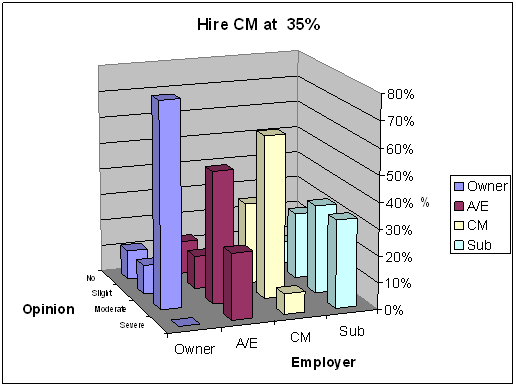
By CMAR experience: 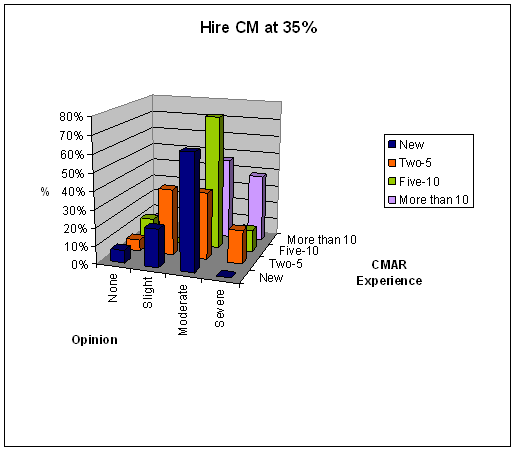
However, how negative is the impact if the CM is not hired until midway in the design, say 35% complete or 65%? At 35%, there we no significant differences between the respondents, sorted by employer or by CMAR experience. Note that the
Observation 35%
By employer, more A/Es and Subs felt it was a sever impact not to hire until 35%, while less CMs and no owners felt it was severe. By CMAR experience, none of the respondents new to CMAR felt it was severe, while those with more experience did, of those with over 10 CMAR project, almost 40% felt it was severe. If we group None and Slight and Moderate and Severe, we see quite a difference between the those newer to CMAR and those more experienced.
CMAR Experience |
No or Slight Impact |
Moderate or Severe Impact |
New |
29% |
64% |
Two-5 |
44% |
56% |
Five-10 |
13% |
88% |
>10 |
15% |
85% |
Analysis
A tentative conclusion is that with those with more CMAR experience believe it is harmful for the project to start the CM at 35% design, the schematic design, when the main project concepts, but not many details, have been decided. Why the owners and CMs seem less concerned about this that the A/Es and Subs is interesting. Below we will discuss this more.
Next we consider not hiring the CM until 65% design, the design development stage. 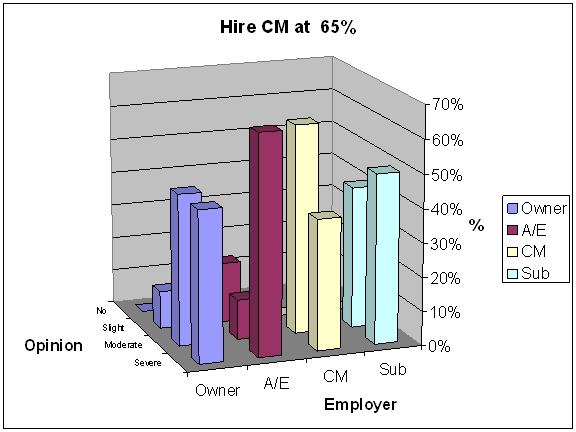
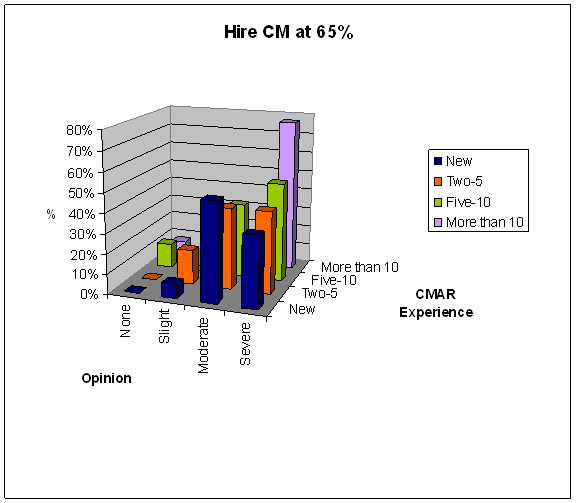
Observation 65%
By 65% more owners and CMs see a problem and more A/Es see it as severe. Regardless of experience, most see it as moderate or severe to not hire until 65%. Those with more than 10 CMAR again see it as severe. Regarding the disadvantages of starting the CM later in the design phase, there was a trend for the 35 and 65% completions as experience increased the perceived disadvantage of the late start was increased. Regarding the disadvantage of not starting the CM until the 65% there was a trend, 30% of the CMs and subs felt it was severe, 44% of owners, but 65% of A/Es felt it was severe.
Analysis hireing the CM at the 35% and 65% design phases.
To some extent this is a “no brainer,” the earlier the CM is hired the better. The trend towards seeing the late hiring as disadvantages with more CMAR experience is quite clear. But examining culture and stress between the players, the data indicate that A/Es are more concerned with later hiring of the CM than the owner. Regarding the owners’ attitudes, there is quite a difference between hiring following 35%, when 78% felt the effects were moderate but none felt the impacts were severe, to hiring following 65% when 44% felt they were moderate and 44% felt they were severe. This could imply that many owners felt that lack of CMs input was not critical until the more detailed design, although it would be helpful to have it earlier. On the other hand, of the A/Es 50% felt it was moderate at 35% and 25% felt it was severe, while at 65%, only 12% felt it was moderate and 65% felt it was severe. Contrasted with the A/Es, the CMs seemed less concerned with a late start. This may have an explanation. Until hire, the CM does not have the job and is perhaps competing for it, hence they would rather have it at 65% than not at all. The A/E on the other hand, has the job, and recognizes that any CM proposed changes will be more costly as design details become firm. I don’t have a good explanation for why the owners are less concerned than A/Es or CM. A putative explanation could be that public owners prefer the CMAR system, but often cannot hire the CM until later in the project for administrative reasons. They would rather have the CMAR system with the CM hired late, than be forced to use DBB.
Sometimes a public owner cannot hire the CM until later in the project. Some public projects have funding in stages, and CM funding may be in a different fiscal year. Alternatively, the CM might be selected but not hired because there is no assurance the full project will be funded. Most CMs are not in the consulting business and will not spend resources until they feel sure the job will go ahead. Under those circumstances the CMs input might not be as valuable.
Another key to the attitudes may be in the concept that if the CM (and subs) are brought on early, they can do true constructability and value engineering at the design concept level, i.e., influence the design. If they are not brought on until later, they can still figure ways to cut costs, but they are much more likely to interfere with the deign concept. So the CM and Subs, while they would like to start early, can still get the job done – build on schedule within budget – despite being hired late. For example, for the subs, if they are not brought into the design until late, they can only substitute cheaper components. On the other hand, the A/E sees late hiring as an invitation to sub-optimize the design. They see the CM and Subs satisfying their duty - getting the job built on time and within budget – but leading to a failure in the A/Es duty to design the facility with the best value for the owner.
Comments on the A/E preconstruction questions?_____________________
Text Comments
Most of the comments support the obvious – hiring the CM earlier is better. The full text of all the comments is linked here, but here I will present certain interesting or informative comments. My comments to the comment are in square brackets:
- Theory tells us that much of the added value in CMAR is the contractor’s input during pre-construction phase. The earlier he is hired, the more useful his input is and the more impact it can have without changing already completed work. [Of course this “completed work” must refer to A/E design.]
- The intensity of CM involvement does not necessarily need to by high in the early stages, however, it is extremely important that the CM be involved to some extent at the start of schematics. This is when expectations are formulated and critical decisions are made. Project decisions start with a view of the “forest” and work their way to the “trees”, and the CM can provide valuable insight during those “forest” decisions. As the design advances through schematics, design development, and construction documents, it becomes increasing more difficult and eventually not practical to change direction as a result of critical information provided by a CM whose preconstruction services began in some later stage in design. [This commenter distinguishes the depth of CM involvement, a good point.]
- We prefer the CMAR to be brought on at the same time as the design professional. We have formal partnering sessions and create the goals of the project together. Some decisions are made jointly. We have even co-located with our contractor partner so that decisions are made side-by-side. (CMAR moved into DP’s office for the design phase before moving into the on-site construction trailer for the construction phase. [Another good point – it does not good if the CM is hired, but is remote from the project.]
- The CM and Key subs should be hired as early as possible in the project. [We’ll talk more about subs later. CM without subs might not be helpful.]
- The A/E without input from both the prime contractor and the larger subcontractors can over design, under design, not use economical materials, non state of the art material, materials that are not available, or processes that don’t take into account what the available work force can perform.
- In my experience, the CM is anxious to prove their worth to the Owner right from the outset, which usually means “value engineering the design”. The CM is also interested in minimizing the “risk” aspect of CMAR and broadening the buffer between their GMP and what they believe will be the actual cost. Since this almost always means decreasing the cost of the project, the scope and quality of the design are directly affected, usually negatively. To keep cost, scope and quality in equilibrium, it is imperative that value engineering occur as early in the design process as possible. Engaging the CM at the outset promotes a better working dialogue between the A/E and the CM, and the design stands a much better chance of proceeding with scope and quality in better alignment with cost. The later the CM is engaged in the process, the more likely “value engineering” will become an exercise in reducing cost without much regard for overall design impact or material performance, like making Monterrey into Swiss Cheese. [Good point. If the CM is hired early, they may do value engineering, while if they are hired later, they tend to cut costs, perhaps with less respect for value.]
- The University of [state] System which manages our campus CIP projects requires a Guaranteed Maximum Price (GMP) be provided for Board of Regents approval at the 100% DD phase. The longer it takes to hire the CMR, the more negative the impact on the project scope and budget.
- The benefit of the CM process is the ability to gain cost, schedule and constructability input from the constructor who will eventually do the work. During or at the end of Schematic Design is the ideal time to bring the constructor onto the team. This is the time when their input has the greatest positive benefit to the process. All major design and system decisions should be made by the end of the DD phase. Schedule decisions related to fast track packages must be made during DDs. As a result, significant input delayed until the CD phase has the greatest potential to add cost to the design team and to negatively impact the project schedule. Additionally, the process of getting a GMP will require considerable project knowledge by the constructor. They naturally tend to push the actual GMP setting as late in the process as possible, often offering mini-GMPs for early packages while the later packages are being developed. Waiting until CD phase to bring on a constructor is not likely to result in an early GMP and the entire team will have lost most or all of the schedule and constructability benefits. If a constructor has not been brought onto the team by the start of CDs, I would recommend serious consideration toward simply bidding the project.
- Success with constructability reviews during pre-construction has varied, and A/E questions have been fairly limited. Most discussions are cost related. These continue throughout the pre-construction phase, and although many ideas are generated and incorporated, the GMP often comes in higher than the budget, and more serious scope reductions are considered. [Good point, the CM’s input tends to be about costs – but the costs can still be over the budget.]
III. Preconstruction services of subs
Some CMR-contracts do not allow hiring of subcontractors until later in the process, after the design is 95% complete. This leads to questions about how the CMR will provide preconstruction services relating to specialties – mechanical, electrical, etc. How do you feel about these statements?
A. “In my personal experience, this is not a problem because most CMs have sufficient specialties experience to provide preconstruction services in all the main specialties.”
Score 1-5, where 1 means strongly agree and 5 means strongly disagree.
____________Score
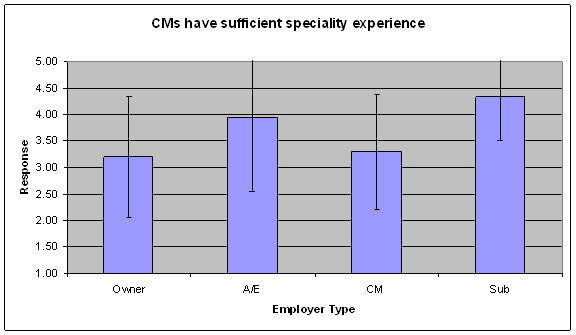
A response of “1” would indicate strong agreement with statement and “5” would indicate strong disagreement. I assume a “3” is neutral, neither agreeing nor disagreeing.
Observation
The average score was 3.73, indicating general disagreement with the statement. The difference of opinion based on employer type is significant. The difference between subs and CM is significant (at 95% confidence) and the difference between subs and owners is significant (at 90% confidence). [You can see the STATISTICS section for technical discussion of “significance,” but here it has the usually English meaning.] The difference between A/E and subs is small and not significant.
There were no significant differences between CMAR experience, although those with more than 10 projects, disagreed more strongly 4.21 than the average.
Analysis
While the difference between CM and subs is predictable, the difference between owners and subs is not, nor the lack of difference between A/Es and subs. Presumably, the A/Es would be in the better position to judge the technical expertise of the CM regarding a particular specialties, i.e., the electrical engineer viz a viz the electrical contracting. The greater disagreement with those with more than 10 CMAR projects could indicate that they have encountered projects with lack of specialty expertise is a problem, although those new to CMAR also disagreed more than average. See more analysis of the sub issue below.
Text Comments.
- Our experience is that very, very few CMAR’s have more than broad trade experience and almost none have sufficient MPE [mechanical, plumbing, electrical] or other specialty sub trade experience. Consequently, most can offer some broad estimating, and generalized knowledge of systems or MPE designs, but getting into details is nearly a worthless exercise with them.
- More comments.
B. “In my personal experience, this has not been a problem because the CMR was able to bring appropriate specialty contractors into the preconstruction process, even though they were not under contract.”
Score 1-5, where 1 means strongly agree and 5 means strongly disagree.
____________Score
Observation
There were no significant differences either by employer or CMAR experience for this question. The average response was 2.63 but with a standard deviation of 1.17, which indicates slight agreement on the average, but with widely varying responses.
Analysis
There was no trend to the responses to the second question. The overall answer indicates slight agreement. It may not have been worded well. Perhaps it should have been worded, “If the CM did not have sufficient specialty experience in-house, were they able to bring ….” Overall, it is clear that subs and A/Es feel CMs do not have sufficient specialty experience in-house, but that deficiency may be covered by bringing subs in early. The nature of “bringing the subs in early” is mentioned in the text comments that follow. Also, more on that below.
Text Comments
No subcontractor will provide preconstruction services at no cost unless the CM has indicated a commitment to use that subcontractor for construction. Subcontractors are in business to provide and install their respective specialty systems, not provide consulting services. It is unethical to expect them or anyone to perform such a time-intensive service without compensation, then award the installation to a low bid competitor who would not have been capable of providing the same preconstruction benefit to the Owner.
This may be more a reflection of the construction climate now, but very few specialty contractors have the time to do a really good estimate or quality or design review of pre-construction work. They’re just too busy. If they do, it’s as a favor to a general contractor who works with them a great deal, but even so, the sub’s heart and best people typically don’t have the time, even with the agreement that “if you help me with this, I promise that you’ll have the chance to price the work later (under a competitive pricing offering…..). Most would be willing to help if you would either hire them early or guarantee that they’ll be hired later. I think that a better alternate question to owners might be, would you be willing to pay some small amount to have a specialty contractor review the documents for design, quality control and provide a reasonably accurate estimate? I think that we’d seriously consider it, and probably either make sure that the CMAR does this or slightly reduce the CMAR’s pre-construction phase fee and agree to pay these fees ourselves directly.
C. “In my opinion, if there were no legal, policy or political prohibitions, the subcontractors should be hired early in the design process based on qualifications, paid standard rates for preconstruction services, then fees negotiated after design is near completion.”
Score 1-5, where 1 means strongly agree and 5 means strongly disagree.
____________Score
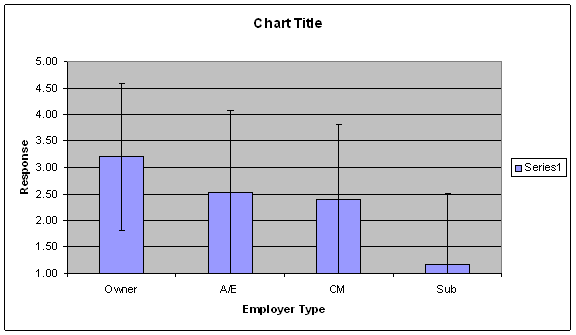
Observations
There is a very clear trend in the averages, owners disagreeing slightly, A/Es and CMs agreeing somewhat, and subs agreeing wholeheartedly. But note the very wide standard deviations. That is, there was little agreement within the owner group on the questions. The same was true of A/Es and CMs. This wide variation within the groups made the differences between the groups not statistically significant. There were no differences on number of CMAR projects.
Analysis
The date present two questions: One is, why do the owners disagree with the A/Es and CMs on this point? The second question is, why is there such disagreement within the groups? The text comments indicate one possible answer to the first question. Public owners who want to use CMAR still want to show the legislators/funding agencies/public that they are getting the most for the money. Bidding subs is one way of approaching this. CMs and A/E however feel they are always striving to maximize value and bidding does not help their objectives. The wide variation in responses within the groups may relate to the question. The complexity of the work and the likely variation in system design and cost and is not the same for all specialties – some will have only minor impact on the final project. And not all projects are the same. Some projects are quite complex and others are relatively straightforward. If the survey question had been limited to subs that are likely to have a large impact on the final product and its price, the results may have been more uniform.
Text Comments.
1. This is not unlike the process used in hiring CM’s. A qualifier would be needed defining “conditions” for limiting a project’s “preconstruction” subcontractors to only those whose preconstruction input is considered to be essential to the successful outcome of the project and benefit to the Owner. The remaining subcontractors should be appropriately competitively bid.
2. More comments.
D. In my opinion, ideally, the subcontractors should be hired early in the design process based on qualifications, paid standard rates for preconstruction services, then required to bid on the work with several other prequalified specialty contractors.
Score 1-5, where 1 means strongly agree and 5 means strongly disagree.
____________Score
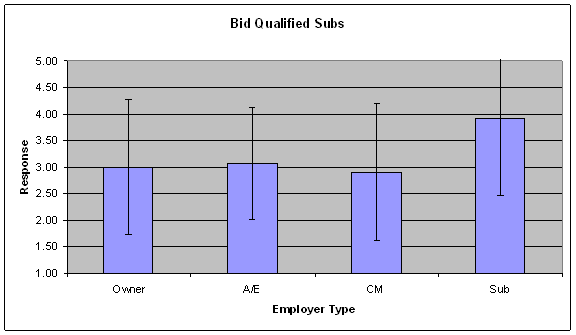
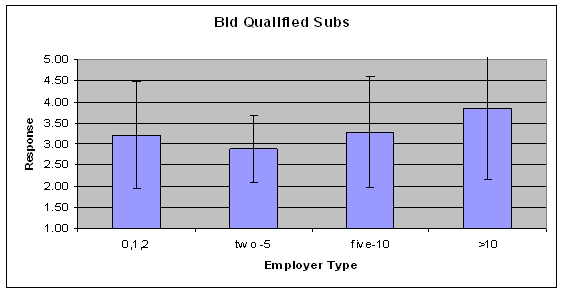
Observation
Owners, A/Es, and CMs were neutral on this question, while subs disagreed. There was a clear trend based on CMAR experience, those with more experience disagreeing more. In neither the employer type nor CMAR experience were the results statistically significant.
Analysis
The lack of statistical significance was due to the variation in the responses. That may have been due to the wording of the question. A respondent may have disagreed about the need for prequalification or the low bid. The trend towards disagreement with increase CMAR experience may be due to confidence that fair prices can be negotiated and/or problems with low bid sub.
Text Comments
1. The subcontractor who provides preconstruction expertise is providing a professional service similar to the architect and CM. There is intellectual property involved. The architect would not want to design a project and bid against other architects for construction administration services (typically 1/3 of the architect’s total fee). The CM would not want to provide preconstruction services and bid against other CM’s to manage the construction. [Only comment]
E. If there were legal or policy prohibitions against negotiating subs rather than bidding, would you be willing to lobby for removing that prohibition?
Score 1-5, where 1 means strongly agree and 5 means strongly disagree.
____________Score
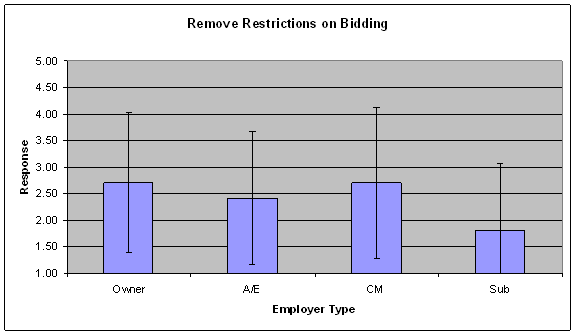
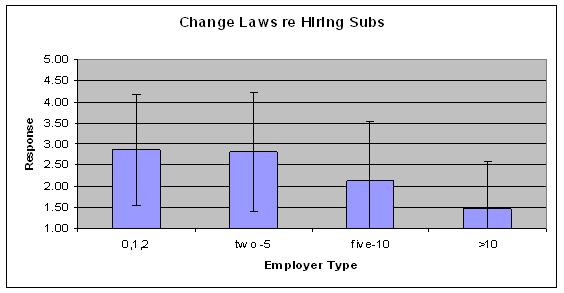
Observations
The average score, 2.37, indicated some agreement, but there was a wide standard deviation. Based on employer, there is a slight trend that subs agreed more, and owners and CMs less, but these are not statistically significant, note the large SD. There was a statistically significant trend with CMAR experience, the more experienced were more willing to work to change the system to permit negotiations. Those with over 10 CM projects were more wiling to try to change the system to permit negotiations,
Analysis
Subs were very willing to work to change the law, as would be expected. The average response of owners, A/Es, and CMs (2.60) indicates some willingness to work towards negotiations with subs. See meta analysis below.
Text Comments
1. A qualifier would be needed defining “conditions” for limiting a project’s “preconstruction” subcontractors to only those whose preconstruction input is considered to be essential to the successful outcome of the project and benefit to the Owner. The remaining subcontractors should be appropriately competitively bid.
2. Other Comments.
GENERAL Comments on Preconstruction Services of Subs
Here are two typical comments
1. With some exceptions, most of GC’s are NOT master builders, they are brokers. The best bring seasoned superintendents into the pre-con services, but even they can not support the technical issues for MPE systems. And in my experience, you get what you pay for- free services with no guarantee of work, no matter how well intentioned, is almost worthless.
2. For the process to work the most efficiently and for all the benefits to be realized the major subcontractors need to be involved from the beginning. All to often the subcontractors are solicited for no reimbursement and if they are not sufficiently compensated on that project or another project they will not participate again in the process with the GC.
3. [However several commenters noted that] bidding helps keep the subs “leaner and more precise” and “bidding the sub-contractors is a way to answer to the governing board that we have achieved fair pricing.” All the comments are available here.
Analysis
There is general agreement that CMs do not have sufficient specialty expertise and thus input from specialty subs is needed in the pre-construction phase. Also, the earlier in the pre-construction subs are brought into the design process, the better. And the more complex the project or specialty work, the more important it is to bring the key subs in early. Let’s look at some of the issues in more detail.
The difference between owners and A/Es is interesting. Let’s contrast Owners with A/Es across the questions:
Question |
Owners |
A/Es |
Confidence |
III A CMs have specialties |
3.2 |
3.94 |
93% |
III B CMs bring specialties |
3.0 |
2.74 |
89% |
III C Negotiate with subs |
3.2 |
2.53 |
89% |
III D Bid qualified subs |
3.0 |
3.06 |
none |
III E Remove bid requirement |
2.7 |
2.41 |
none |
We see that A/Es, the party that has the least economic interest, but with a strong quality and performance interest, do not believe CMs have sufficient specialty experience and that CMs need to bring subs into the process. Further, A/Es are comfortable with negotiating with subs and would like to do more of it. The last column is the statistical confidence that owners and A/Es responded differently to this question. So why do owners and A/Es have a different opinion on this issue?
Several of the text comments indicated that owners want to demonstrate to their funding agencies that they are seeking competitive pricing wherever possible. Forcing the subs to bid accomplishes this, since on many building projects the majority of the work is subbed. This brings up the issue of how the subs can be brought into the pre construction/design process if they will be asked to bid on the work.
While it is possible to select subs based on qualifications and pay them as consultants, most subs are not organized to provide consulting services, they are in business to the profit from the construction phase. Unless they are sure they will get the work, they have little incentive to bring their A team. (I’ll note here that this is the same if a CM is selected for an unfunded project, they have little incentive to give it their full attention until the project is funded.)
Regarding bidding and competition, there are some subtle issues that need to be considered. First, one sub’s value engineering advice may be specific to their equipment, supervisors and suppliers and a different sub might approach the job differently. So, if the project is to be bid later, the sub would have an incentive to build such differences into their design input, thus giving them a competitive advantage in the bidding. Of course, s really seldom practical to skew the design in that way, but the sub’s competitors are likely to believe accuse them, the CM, and the owner anyhow.
Another fairness issue with bidding is that the subcontractors involved in the design process have a better understanding of the intent and requirements of the design and subsequently bid accurately, while a competitor might bid differently, i.e., the sub active in preconstruction may know where he can cut corners during construction while the naive sub does not. Again, with qualified subs, this is unlikely to be a real problem, but might easily be a perceived fairness issue.
Another issue is that a sub may be quite good at estimating costs and building what is designed, but weak in working with concepts early in the design stage. Such contractors would be at a disadvantage being selected on qualifications.
The subs that responded to the survey were in agreement that negotiating was best. Ten of 12 scored it “1,” strong agreement, and the other two scored it a “2.” So, regarding the fairness, the subs that responded did not see a problem with negotiating. Of course the sample was limited to subs who have worked on CMAR projects, so it may be biased against small or new subs who do not have the qualifications for major CMAR projects and may perceive the issue differently.
Conclusion
The data and text comments support the proposition that owners would like to negotiate subs early in the project, but need assurance that they are still getting the best price for the work and want to be able to demonstrate this to the public, and from the owners viewpoint that these slightly outweigh the lack of specialty expertise of CMs.
It is often assumed that a negotiated price would be higher than a bid price, all other things being equal. This universally recognized as untrue, if there are only on or two bidders. A contractor negotiating a price has an ethical obligation to be “fair and reasonable,” while a bid price may be “as high as the market will bear.” As qualifications based selection becomes more common in public construction contacting, a negative job may cost a contractor more in the long run, hence a contractor that takes advantage of a situation may loose in the long run.
Here is an important culture concept. While the owner may personally trust the contractor, a public owner must be able to demonstrate that he is making wise use of the public money – getting the best bargain for the taxpayer. Hence the public’s reaction must also be considered part of the culture. On the other hand, jobs that finished over budget, behind schedule, and covered up with lawsuits are not wise either.
One issue public owners face is perceived fairness. Most owners mangers do not want the funding bodies (legislatures or what) to supervise details of their contracting procedures or otherwise involve themselves in the project – other than getting their names spelled right on the brass plaque, that is all the legislatures want as well. The legislatures will not interfere based on their analysis of the situation, but rather will react to complaints by their constituents. The pressure to not use CMAR will not come from the public or legislators themselves, but will be generated by disgruntled contractors or subs, who will complain to the legislators or other funding bodies.
One method of minimizing such pressure is to have a decision process decided in advance as an SOP, see matrix below. Although the evaluation of complexity and cost risk is inherently subjective, descriptive definitions for the degree of complexity and cost risk can be written. By having such a matrix in the SOP, early in the job the owner, A/E, and CM agree on the subcontracting strategy for each specialty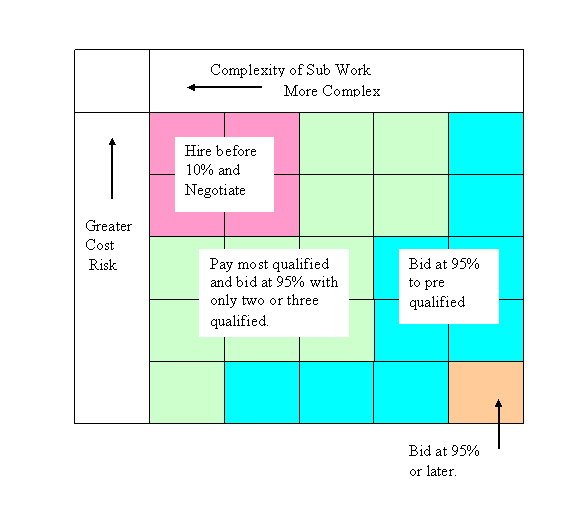
IV. CMR selection.
1. If the general project scope and budget is known, it would be practical to have the CM propose fees along with qualifications in a two envelope procurement – qualifications evaluated first, then fee. If the state law did not preclude it, what weight should the fee be given in a two envelop selection of a CMR:
___ None/fees should not be a factor in selection
___ Small weight 10 to 20 % of selection points
___ Moderate weight 30 to 40 % of selection points;
___ None of these – the system should be arranged to require bidding by qualified CMs.
Observations
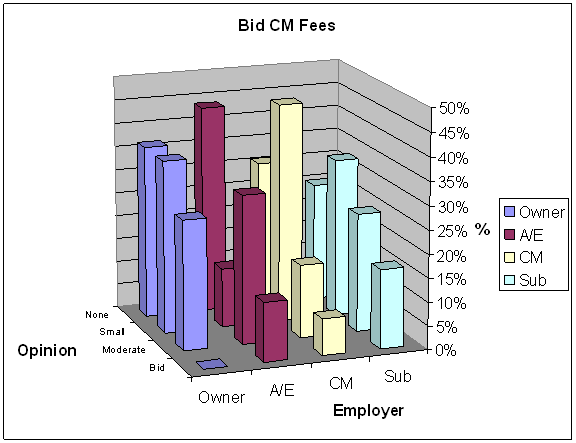
Only 10% of the total respondents wanted to bid the CM fees and none of the owners did. Note that more of the CMs were willing to include fees if they were given only a small weight.
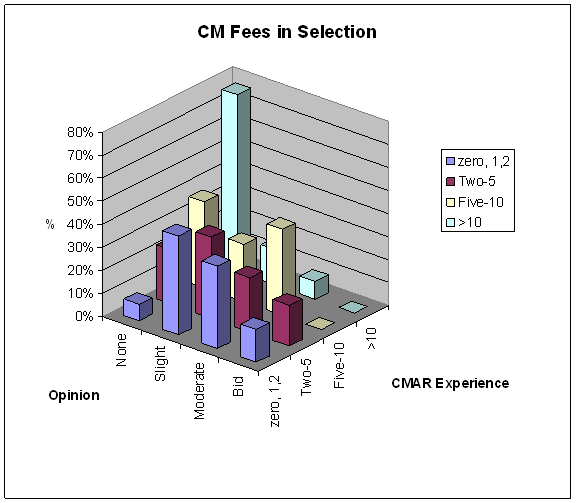
When examined by CMAR experience, it is clear that those with more experience did not think fees should used in CMAR selection.
Analysis
Clearly those with more CMAR experience felt fees should not be used in selection compared to those with less CMAR. The culture change is clear here. Note the one cogent comment, if a public owner lets fees be introduced at all, they are likely to become a driver. The qualifications are likely to all, or almost all, qualitative, but the fee will be quantitative. If there is a dispute, the loosing CM’s lawyer will cry, “but our fee was lower.” The owner’s attorney would have to point to lengthy subjective analysis of the qualifications.That may be the reason those with more CMAR experience don’t want any fee considerations in CM selection.
Note also that CMs are not against including fees so long as they are a small part of the selection criteria. This may be a trust related issue. If fees are not included in selection, the owner managers may not feel comfortable that they have negotiated the best fee. As trust builds in later CMAR contracts, the owner is more comfortable with fees negotiations – of course with increasing CMAR experience the owner’s manager is likely to be more confident in negotiating and have knowledge of fair and reasonable fees.
Text Comments
See text comments here.
V. Teamwork and Partnering
Let us define “teamwork” here to mean “excellence of communications and cooperation that expedites achieving joint goals.”
A. “From my perspective, regarding governmental projects, teamwork is much better on CMR contracts than design-bid-build.”
Score 1-5, where 1 means strongly agree and 5 means strongly disagree.
____________Score
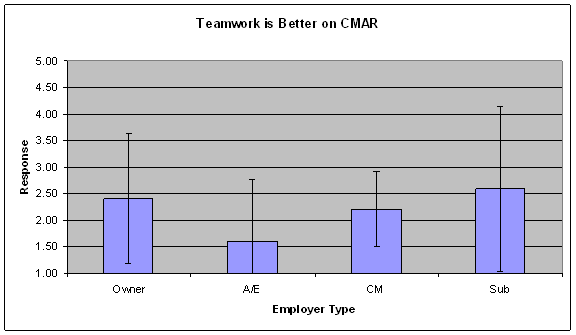
The overall average, 2.1, indicates general agreement. There was an almost significant trend that A/Es agreed more (1.59) while owners agreed less (2.40). Subs agreed least. There was no trend with respect to CMAR experience.
Analysis
Since if subs are bidding the work competitively and not used during preconstruction, they may see no difference between CMAR and DBB. It is interesting that A/E have the highest opinion of teamwork, since the A/E is most likely to have a negative economic impact from the CMAR process – if there are many changes to the design. This may be because in DBB the contacts between contractors and A/E are not frequent, but what contacts there are may be stressful. In CMAR the A/E and the contractors meet more often and on (presumably) more cooperative basis.
Text comments
1. Successful projects are ultimately the result of the efforts of a competent, cohesive team working toward the common goal in achieving the vision of the government Owner. The continuing rise of CMR projects and well-documented failures of design-bid-build projects on government projects are testament to the effectiveness of teamwork using CMR
2. We generally get decent teamwork during pre-construction phase, but everyone has to understand that regardless of what the theory is, once we enter into a contract that has any kind of fixed or set costs element, the contractor’s only motive is to meet his schedule and budget. There is more- or sometimes slightly less- reversion to an adversarial relationship at this point. You see it almost become manic- depression: the contractor is trying to be helpful, cooperative all the while working really hard to protect his profit and move the project along.[Last comment]
B. From my perspective, regarding governmental projects, teamwork improves with the number of CMR projects the team members have completed.
Score 1-5, where 1 means strongly agree and 5 means strongly disagree.
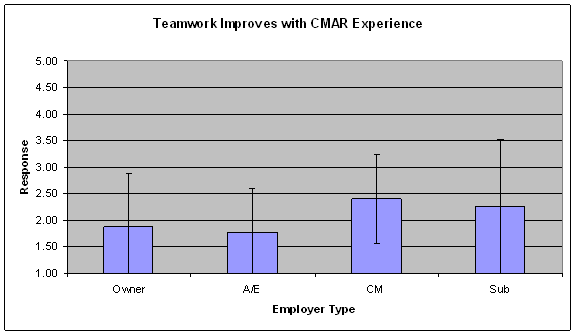
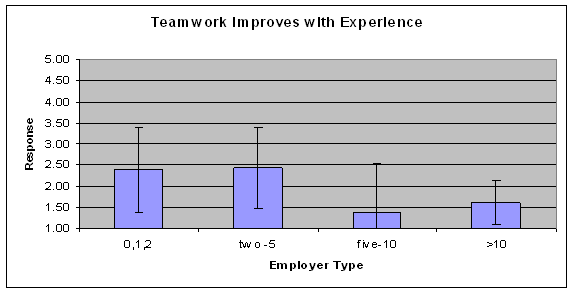
Observations
The average score, 2.04 indicates general agreement. There were not significant differences based on employer. Based on CMAR experience, there was a significant trend towards those with more experience agreeing more.
Analysis
Of course those with only a few CMAR projects would not have a large base to compare teamwork improvements, but teams are usually different for each project and, for example, an owner’s rep inexperienced with CMAR might be on a team with an A/E with extensive CMAR experience. Thus one with less experience might recognize improvement. Anyhow, the data supports improving teamwork with experience, or at least the belief that it improves.
Two commenters bring up good points. First the CMs background, those with design-build and negotiated background will adjust quickly. Those with public DBB experience will need time to adjust. Second, once a CM has made the adjustment, they probably will not get much better with time. Overall, however, there is agreement that teamwork improves. Also, while the CMs transition from DBB to CMAR is somewhat predictable (if they are to be successful in that type of contracting) the transitions of the A/E and owner are also a vital part of teaming. If subs are bid, the relationship may be less of change.
Text Comments
CMR is a delivery method that is more compatible with construction firms that have done primarily negotiated and design-build work. Their mindset is to provide quality and maintain reputation in order to be selected on future work. Firms that do primarily traditional design-bid-build work are different. Their mindset is to win the job with the lowest price and manage close to their margins, through strict interpretation of the contract and construction documents. Teamwork improves with a firm experienced in CMR and other negotiated deliveries, rather than experienced in design-bid-build.
It’s probably a case of diminishing returns. Once you’ve been able to make a transition (if you can) from hard bid mentality and adversarial stances to theoretical partnering and cooperation, and gain the experience of a couple of projects, teamwork then will be about as good as it’s going to get. There probably won’t be much more significant improvement no matter how many more projects we do. There will be an occasional new trick now and then that we learn that will help.[No more comments.]
C. Partnering: Have you participated in a formal (outside moderator) partnering lasting at least a day for any major project – CMR or non-CMR
Check/X one:
___ Yes
___ No
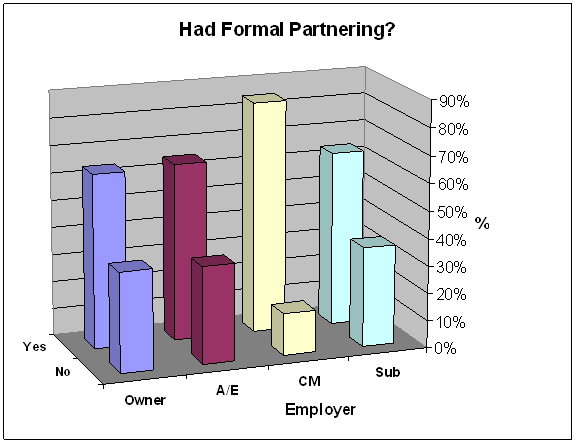
Observation
Overall, almost 70% of the respondents had some formal partnering training. By employer, CMs had more partnering, almost 85% of CMs had. By CMAR there was a slight trend towards more yes with experience, as would be expected.
Analysis
None.
Text Comments
None.
D. “In general, for a major project (CMR or non-CMR), a formal partnering session is worth the time and expense.”
Score 1-5, where 1 means strongly agree and 5 means strongly disagree.
____________Score
While the employer results are not significant by ANOVA, there large SDs, there is a trend that A/E agree more, while owners agree less (they usually pay for the partnering). Based on CMAR experience, there was a clear trend that those with greater than 10 projects thought it was worth it (avg response 1.75) while those with 0,1, or 2 with avg response, 2.83.
When only the responses of those who had taken a formal partnering were counted, there is now a clear and statistically significant trend for those with more experience to agree more. By employer, there was no significant difference, but again there was a trend with A/E believing it was worth it, while owners less so.
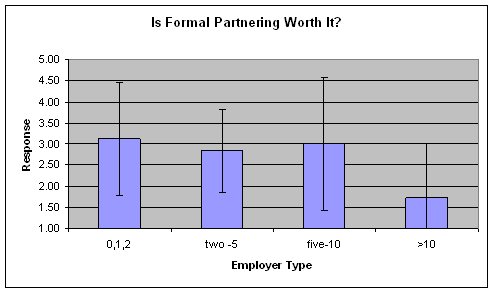
Analysis
When only those who had actually done a partnering were considered, there was a trend toward agreeing more with more CMAR experience. Note that those with more experience have probably sat through more sessions as well, but the trend indicates they have not burned out. Perhaps the comment explains some of the variance in the responses, “It depends on the objectives, the facilitator, and the process utilized.”
Text comments
It depends on the objectives, the facilitator, and the process utilized.
E. Do you believe that formal partnering for your first or second CMR project was/would have been helpful? (Leave blank if you have not done a partnering.)
Score 1-5, where 1 means strongly agree and 5 means strongly disagree.
____________Score
Observation
Overall there was a trend that A/Es agreed the partnering would be helpful, but owner were neutral. Again, there was a trend that those with more than 10 CMAR project agreed partnering would be helpful.
Analysis
The intent of this question and the next was to determine if there is burn-out in formal partnering. That is, if the value of partnering declines with number of partnering sessions attended. Here we found little change from question D. See next.
F. Do you believe formal partnering for your later CMR projects, after the first two, would have been helpful?
Check/X one
___ I’m still on first or second,
___ Should have significant partnering for all major projects
___ Somewhat less important for me, but may be good for others in the project
___ Waste of time.
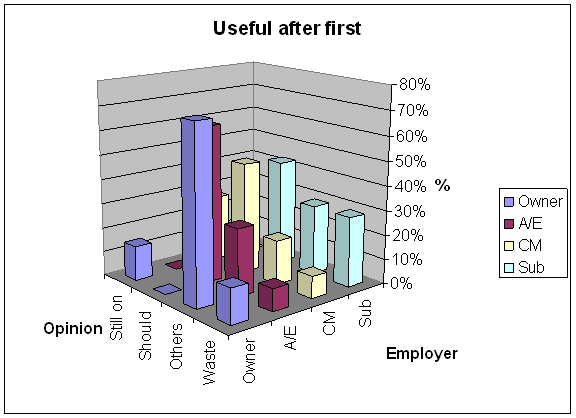
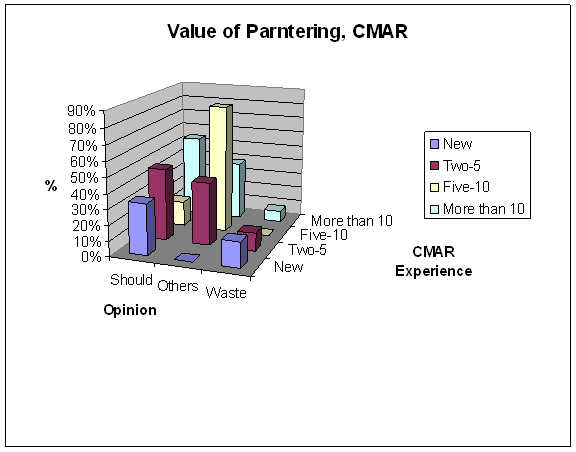
Sorting by employer, note subs seem less enthusiastic, almost 30%, but 71% felt it was good for them or at least for others. The owners are also interesting, none felt they should have the partnering for later projects, but 71% felt it might be good for others. Based on CMAR experience, fewer of the 5-10 and >10 felt it was a waste. If we combined “should have” and “good for others” as positive comments versus waste we find:
|
Should plus Others |
Waste of Time |
New to CMAR |
33% |
17% |
Two to Five |
88% |
12% |
Five to Ten |
100% |
0% |
More than Ten |
92% |
8% |
Thus with increasing CMAR experience there is an increasing positive reaction to partnering for later projects and a decreasing negative reaction.
Analysis
Remember, the owner usually pays for the partnering, and is thus more likely to perceive something as a waste, if benefit is not derived. However the owners were generally neutral on this question. The fact that those with more CMAR experience favored partnering does not support the concept of burn-out with more partnering.
Text Comments
It’s a bit like saying that every time your kid wants to make a new friend, you’re going to run an afternoon partnering session. At some point, we’re all adults and need to figure out how to get along with needing to sit in a room and sing Kumbaya
Either a person or organization is of the mindset to trust and work in a CMAR environment or not. If they are not, no amount of partnering will make it a success.
The formal discussions of goals, aspirations, etc. to me gets tedious and repetitive. I’ll usually invite the CMAR to our early A/E- owner start up meetings and programming sessions to meet everyone, and then pull everyone aside during a break or afterwards for a quick discussion, hi-howdy, etc.
G. Do you feel meeting/socialization of all major project participants early in the project – a meeting/socialization less formal partnering but more than routine progress meeting, for example, a picnic or catered lunch, is a benefit to the project?
___ No real benefit/probably a waste of time,
___ Perhaps some benefit,
___ Probably beneficial,
___ Good idea/I’d recommend it.
Observation
Overall 60% felt they it was probably beneficial or would recommend it, while only 10% felt it was a waste. However Owners were skeptical, only 45% would recommend and almost 20% felt it was a waste. So there was a trend lowest to highest, owners > A/E > Subs/CMs Based on length of CMAR, those with 5 to more than 10 none felt it was a waste. But no trend.
|
No, waste |
|
Probably and Good |
Owner |
18% |
|
45% |
A/E |
6% |
|
59% |
CM |
8% |
|
67% |
Sub |
8% |
|
67% |
If we group “Probably Useful and “Good, I’d recommend it” and contrast that with “No, waste of time,” we see a few more skeptical owners, while about two-thirds of the other parties are favorable.
|
Probably + Good |
Waste of Time |
New to CMAR |
71% |
14% |
Two to Five |
47% |
18 |
Five to Ten |
43% |
0% |
More than Ten |
71% |
0% |
Looking at CMAR experience, we not that the negatives decrease with CMAR experience.
Analysis
While those who have done a formal partnering are generally favorable to the value of partnering and this increases with number of CMAR project, there is some strong sentiment, albeit a minority, that feel it is a waste of time. Generally there are more owners who disfavor partnering, but of course, they are the party that pays for it. Regarding the value of partnering after the first, subs are more likely to feel it is a waste of time. An explanation for that is the a sub’s managers may supervise more projects and hence be drawing into more partnering sessions and become burned out on them. In general there is an increase in positive attitudes towards partnering with increase CMAR experience.
General Commens on Partnering
Text Comments
There were many cogent comments. Among the interesting points was that not all the team may attend partnering, especially subs, if they are not selected until later in the project. Also, if someone is forced to attend partnering, their attitude might preclude them getting any benefit out of it. Several commenters said that partnering is no substitute for integrity and a “good attitude” on the part of team members. See all comments here.
VII. Areas of Tension. Following asks your opinion about potential for tension between the parties. Following this, you will be asked if there are other areas of tension.
A/E design. First some general comments: The CM will review the A/E’s design and make suggestions about cost savings and constructability. Some of these may affect the A/E’s design concept. Of course there is always a trade-off between aesthetics/utility/maintainability on one hand and cost/constructability on the other hand.
A. In my opinion, regarding tension between the A/E and the CM:
Check/X one
___ This is seldom a problem
___ This is a likely problem, but the owner often sorts it out (i.e., need a strong competent owner’s rep)
___ This is a likely problem, but the team usually sorts it out (i.e., A/E and contractor generally handle without too much owner involvement)
___ This is often a problem.
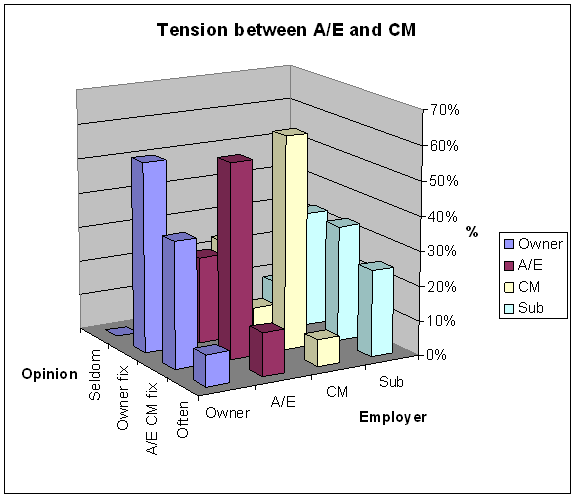
Observations
Of all responses, only 9% felt it was seldom a problem. However CM felt that way 23%, while none of the owners felt that way. Feeling it was often a problem, owners and CMs felt that way 8/9% of the time, while A/E 13% and Subs 25%. That is, subs were less confident that the parties can overcome this tension without leading to a “problem.”
How the problem is resolved, 55% of the owners felt they fixed the problem, while 56% of AE and 62% of CMs felt they fixed the problem.
|
Seldom |
Owner fixes |
Team A/E, CM fix |
Owner |
0% |
55% |
36% |
A/E |
6% |
25% |
56% |
CM |
23% |
8% |
62% |
While there is agreement that it’s a problem, and that it’s fixable, note that there is disagreement about which party fixes it. The owner feel they do, while the A/E and CMs fell the team does. Only 8% of the CMs felt the owner fixes the problem.
Overall, only 14% believe this is a problem that is not fixed.
Based on CMAR experience, we see a clear trend, with increasing CMAR experience, the respondents are less confident the owner or the CM/AE can fix the problem and
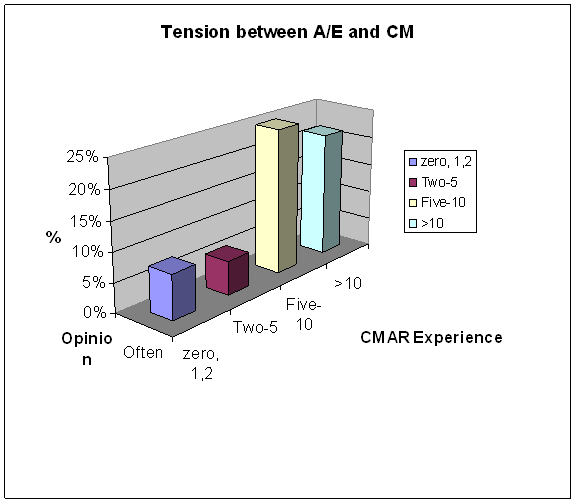
Analysis
Since only a few (5 of 52) respondents felt it was seldom a problem, we can assume this tension is a potential problem that needs energy and effort to fix, but since only a few (7 of 52) felt it was “often a problem,” that most felt is was fixable. The dichotomy of opinion between who fixes it is striking – owners feel they fix it, while A/Es and CMs fell they fix it. Of course some of that is predictable, but I would not have guessed it was so great. Of course a very skillful owner might encourage the A/E and CM to work things out with a minimum of owner involvement.
When relating CMAR experience to this question we not that while they are a minority, 25% of respondents with 5 to 10 CMAR projects and 21% with more than 10 feel it is often a problem, contrasted with 8% and 6% for less experience. It is clear that a substantial group feel that the A/E CM tension is a problem, not easily fixable. Of course negative experiences last longer than positive, so we admit there is a chance that increasing the number of CMAR projects increases the chances of a project with unpleasant experiences
Text Comments
More often, we hear that the architect’s design is over the top and it’s the cause that the contractor can’t make the budget. We hear the same story over and over again about how on the last job, the architect wanted some really fancy, expensive glass and the contractor suggested something a lot cheaper that helped make budget. There’s never much of a discussion about why that original glass was selected and it never occurs or is never stated by the contractors that maybe there was a legitimate reason for the glass selection and it wasn’t just because it looked cool in the design.
B. There may be a tension, if the A/E believes the CM is trying to reduce scope to make the CM’s job easier and/or the CM believes the A/E is trying to embellish the project and pass the risk on to the CM.
Check/X one
___ This is seldom a problem
___ This is a likely problem, but the owner often sorts it out (i.e., need a strong competent owner’s rep)
___ This is a likely problem, but the team usually sorts it out (i.e., A/E and contractor generally handle without too much owner involvement)
___ This is often a problem.
Observation
|
Seldom |
Owner fixes |
Team A/E and CM fix |
Often |
All |
23% |
25% |
37% |
15% |
|
|
|
|
|
Owner |
27% |
45% |
18% |
9% |
A/E |
19% |
25% |
38% |
19% |
CM |
31% |
15% |
54% |
0% |
Sub |
17% |
17% |
33% |
33% |
Observations
Of all respondents, 23% felt this was seldom a problem, but 15 % felt it was often a problem. Here is a stark contrast between CM, none of whom felt it was a problem, compared to one third of the subs who felt it was a problem. Note also that 45% of the owners felt they fixed the problem while the team believes they fix it, (38% and 54%).
Again, regarding CMAR experience, there was a trend only of few of those with less experience
felt it was often a problem (7 and 6%) while more of those with more experience felt it was often a problem (25% and 21%)
Analysis
An explanation for the different point of view regarding who, the owner or the team, fix the problem, may be that the A/E derives his power from the owner. Hence the A/E may be wearing the owners stripes, in which case one could perceive the fixer as the A/E or the owner. Note this notion of “power” is antithesis to the overall team concept, where the team members strive jointly to deliver what the end users want within the project constraints.
Note this question was specific to design issues, while the first question was meant to be general. There was not much difference in the answers
Text Comment
Two answers on both A and B above because all three parties need to be strong participants in the decision making process. Ultimately the AE gets its power from the Owner.
C. Regarding the above, what is your opinion regarding a competent independent estimator is hired by the owner
Check/X one:
___ The situation is improved with a competent independent estimator working for the owner.
___ The owner’s estimator is unlikely to improve the situation, just another opinion in the mix
___ The owner’s estimator is likely to make the situation worse
Observations
By all employers, almost one third felt the owners estimator made things worse. Looking at employers, note the difference, 0% of A/Es felt this way, while 54 and 67 of CM and Subs felt this way. While 65% of A/Es felt the independent estimator improved the situation, only 31% of CMs and 8% of subs felt this way. No trend apparent with CMAR experience.
|
|
|
|
|
Improved |
Opinion |
Worse |
Owner |
50% |
30% |
20% |
A/E |
65% |
35% |
0% |
CM |
31% |
15% |
54% |
Sub |
8% |
25% |
67% |
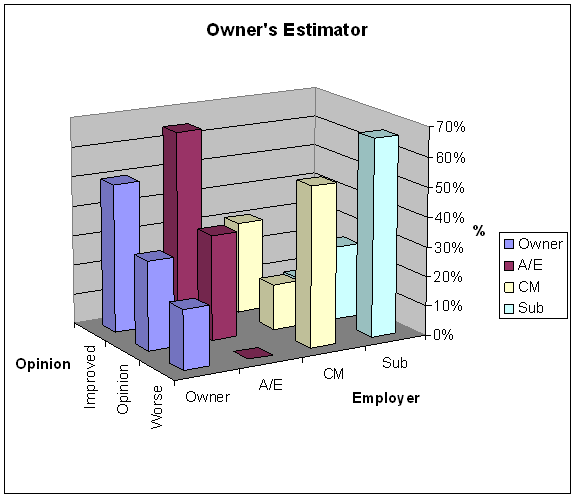
|
|
|
|
|
Improves |
Just Opinion |
Worse |
Owner |
50% |
30% |
20% |
A/E |
65% |
35% |
0% |
CM |
31% |
15% |
54% |
Sub |
8% |
25% |
67% |
CMAR Experience |
Improves |
Just Opinion |
Makes Worse |
zero, 1,2 |
50% |
21% |
29% |
Two-5 |
31% |
31% |
38% |
Five-10 |
63% |
13% |
25% |
>10 |
29% |
36% |
36% |
Analysis
Wow. See comment below, “nearly 100% of the time [owners estimate] is less than the contractors.” So the negative reaction of the CMs and Subs, about two-thirds of them, is that the owner’s estimator will reduce their estimate. This is to be expected. Note about two-thirds of the A/Es feel the owners estimator improves the situation. So clearly this is a point of tension. Also, it does not resolve with amount of CMAR experience. Note earlier, the parties felt they could work things out. Between the questions A, B, and C, we might conclude that the independent estimator often does not reduce tension. This might not be “bad” for the project, tension itself is not bad, only if it distorts or destroys teamwork. Note the one comment below that problems are often due to the program, perhaps even before the architect is hired, and that is the time were an independent estimator is useful.
Text Comments
1. My experience is that GMP problems are too often traceable back to the formation of the original program budget, before the CMR (and often before even the architect) get involved. This is the stage where professional estimators should be employed.
2. The owner or for the A/E. We often hire a third party estimator to further insure that cost estimates are accurate. More comments.
D. Do A/Es feel their designs are constrained – less opportunity for aesthetic improvements and innovations by CMR project deliver systems than DBB? (If you are not an A/E, please give your impressions anyway.)
Score 1-5, where 1 means strongly agree and 5 means strongly disagree.
____________Score
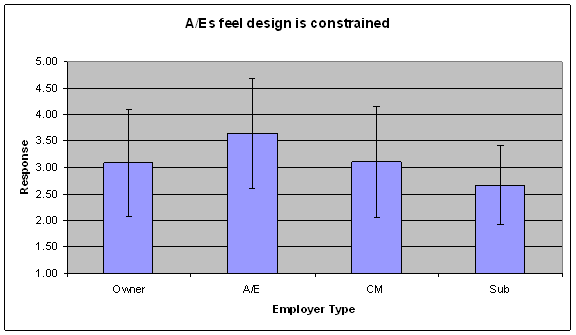
Observations
The average response, 3.13, indicated very mild disagreement, a 3.0 would be neutral. A/Es did not feel they were constrained; with the average score 3.65 indicating they disagreed with the thesis. CMs and Owners were neutrtal and Subs agreed slightly. There was almost a significant difference between those with 5 -10 CMAR jobs and the others, but those with more than 10 did not follow. So there was not a trend for CMAR experience.
Analysis
However the question specifically asks about “feelings,” a value laden concept. The A/E would know how they feel, while the other parties would be guessing. It seems to bode well to teamwork that the A/E felt they were not constrained. However, in the QBS for A/Es, knowing it will be a CMAR contract, the A/Es would be proud of their ability to design what is needed despite constraints.
Text Comments
DBB positions the architect as the sole provider to the Owner during the design phase. It is human nature that any additional expert involvement (CMR, cost estimating, special interest, etc.) would cause the architect to feel constrained
E. Some CMR contracts, and some owners by policy, require the A/Es estimate and the CM’s estimate to be within 5% of each other at the conclusion of each design phase (10, 35, 65% ) in order to progress to the next phase. Do you feel:
Check/X one
___ This is a good policy, if it is rigidly enforced
___ This is a good policy if it is not too rigidly enforced, i.e., 10 or 15% is OK in early phases.
___ Not very good policy, it gives a false sense of security
___ Not very good policy, wastes time
___ Not a very good policy, for other reasons.
Observation
|
Good if rigid |
OK, if not too rigid |
Not good –false security |
Not good - wastes, time |
Not good –other reason |
All |
18% |
41% |
18% |
14% |
10% |
Owner |
45% |
36% |
9% |
0% |
9% |
A/E |
12% |
59% |
12% |
12% |
6% |
CM |
8% |
33% |
8% |
25% |
25% |
Sub |
9% |
27% |
45% |
18% |
0% |
Clearly the owner, A/E and CM/Subs have a different opinion on this. Let’s combine the three catageroies not good because of false sense of security, wastes time, and other.
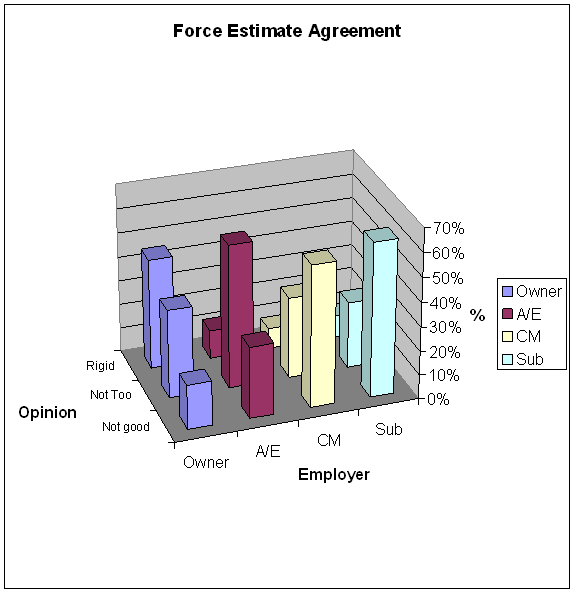
There is a remarkable contrast: owners felt it was good if rigid, A/Es if it was good if loose, and CMs (58%) and Subs (64%) felt it was bad if rigid.. CMs felt a rigid conformance was bad because it wastes time, while subs felt it was a false sense of security. There was no trend with CMAR experience.
Analysis
Unfortunately the text comments did not shed light on what the “other” reasons were. That 45% of the subs felt these rigid requirements led to a false sense of security are very interesting. Perhaps they felt that a rigid number in the early stages was not warranted. In other words, while the center point estimate will agree, see the contract language below, there is no discussion of the confidence limits. Subs feel this more acutely then CM. The logic could be for the CM the high and lows from the subs will average out, making the confidence limits tighter for the overall price, while for an individual sub a high or low estimate will be problematical.
Text Comments
Reconciliation of the estimates is time consuming but a good idea. The costs may not match but the reasons for the differences need to be understood. Ultimately the constructor has the risk and his numbers will prevail.
It is our contract as well as policy. We feel that we need to make sure that we’re all in agreement at certain milestones about where we are on pricing. We may allow a couple of percent variance, but we’re not going to go as far as 10% or 15% at any stage. Here’s our requirement: “At Schematic Design Phase, the difference between the Architect’s and Contractor’s estimate shall be five percent (5%) or less. At Design Development, this difference shall be two and one-half percent (2½%) or less. At Construction Documents/Guaranteed Maximum Price Phase, the Architect and Contractor shall reconcile and agree with the Estimate of Construction Costs or Guaranteed Maximum Price as developed by the Contractor, within the amount of the Owner's Project Construction Budget (Construction Contract Award Price).”
F. In general, do you believe issues related to design changes and A/E fees are: (If you are not an A/E, please give your impressions anyway.)
___ Are often an important impediment to teaming
___ might be an impediment to teaming;
___ not usually an impediment to teaming;
___ have not been an impediment to teaming;
___ don’t know
Observations
The data is easier to interpret if we grouping “Often an important impediment” and “Might be…” and compared that to “Not usually…” and “Have not been…” On that basis, 2/3 of the Owners feel fees are usually an impediment to teaming, about half A/Es feel thus, while about 60 of the CMs and Subs feel fees might be an impediment.
|
Often an impediment plus Might be |
Not usually plus have not |
Owner |
36% |
64% |
A/E |
41% |
47% |
CM |
62% |
38% |
Sub |
58% |
42% |
|
Often an impediment plus Might be |
Not usually plus have not |
zero, 1,2 |
71% |
21% |
Two-5 |
41% |
53% |
Five-10 |
38% |
63% |
>10 |
43% |
57% |
There is a trend to perceive fees as less of a problem with increasing CMAR Experience
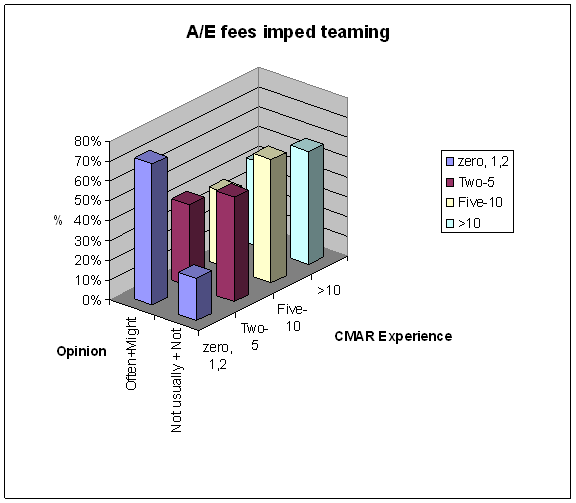
Analysis
This may indicate a tension that CMs and Subs believe a fee issue is at the root of a problem, while A/Es and Owners believe it is something else. For example an A/E is reluctant to change a design feature based on his perception what is on paper is best suited to the owner’s requirements, while the CM and Sub see it as reluctance to put in more work to redesign. On the other hand, with increasing CMAR experience, the team is better able to focus on the underlying problems – but of course if there is a lot of redesign, the A/E will want to be compensated. An important point from the comments is that the later the CM is brought into the design, the more likely A/E fees will become an issue.
Text Comments
If the constructor were brought on late and the changes were significant, AE fees would become an issue. Also lots more meetings during design phases, lots of extra work doing redesign or finding alternatives each time the cost estimate comes in too high, etc…...
G. Relative to DBB, there are far fewer design errors problems in CMR.
Score 1-5, where 1 means strongly agree and 5 means strongly disagree.
____________Score
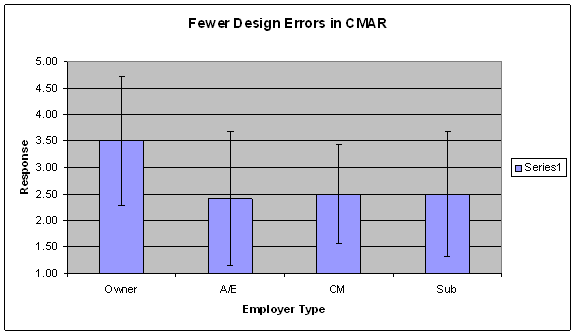
Observation
The overall average, 2.73, indicates slight agreement. There is a clear trend that Owners disagree with A/E, CM, and Subs. Owners at 3.5 slightly disagree, while the others at 2.5 slightly agree and the difference between the owner and the A/Es is significant. No significant difference for CMAR experience.
Analysis
While the difference is small, the fact that owners do not see far fewer design errors in CMAR, while the others do, and the difference between the owner and the A/Es is significant. Owners typically pay for the error with cash, while the A/E pays with reputation and manhours for redesign. The CM and Subs may get paid their cash costs, but generally have disruption that is not compensated. A positive effect of teamwork would be that the hassle and embarrassment of design errors is reduced and their rectification is done more quickly and at less cost than DBB, but the number of errors is about the same. (See below re 1% etc.)
Text Comments
Score depends on when the CMAR and subcontractors are involved in the design stages
I don’t think that we’ve seen an appreciable change in the E and O rate for architects between DBB and CMAR. In theory, as you said, the CMAR’s review should catch a number of things, but we just aren’t seeing that level of review from most CMAR’s. Where we use their reviews is in whether we accept paying them to make the correction of the E and O situation, where we are now telling them that they were involved from the beginning, that they should have caught the error- especially a really obvious situation- during their contract required reviews and they have to figure out how to cover it since we are not going to pay for it.
H. During pre-construction, how often should there be formal meetings (minutes taken and distributed) between the owner, A/E, and CM
___ Seldom or only if special circumstances warrant
___ Only when the A/E finished a phase, typically 10, 35, 65, and 95% design
___ Certainly, at the conclusion of the design phases, but also approximately Weekly
___ [Same] Biweekly
___ [Same] Monthly
Observations
83% of all respondents recommend either weekly or biweekly meeting. There was little difference between employer type or CMAR experience.
Analysis
So there is general agreement frequent meetings are needed. The only other schedule that received votes was “at the conclusion of the major design phases.” There may have been a slight trend towards more frequent meetings with experience. The one commenter brought up the point about the “users” only being invited to the major phase reviews. More on that below.
Text Comments
This really depends on the size and complexity of the project.
Frequency will depend on the scale and schedule of the project / process
Trust doesn’t have a lot to do with the number of meetings- there’s always something that we need to meet about, discuss and decide on. Most of these are between the architect and CMAR, generally with the owner’s rep involved. We may have a couple of intermediate meetings when users may be invited, but generally it’s just for major milestone reviews.
Comments about pre-construction phase?__________
CM’s are only starting to understand and bring value to this phase. Accurate IN-HOUSE estimating is critical, as is independent confirming estimates. The challenge with CMAR is believing you are getting a fair price (the auto mechanic syndrome), so anything that helps the situation is a positive. The best firms bring value by doing REAL constructability reviews, helping solve budget problems with creative solutions, taking responsibility for their document review efforts (not allowing sub change orders based on document “interpretations”) and taking the time to understand and buy into design concepts.
Definitely feel the Architect can get more “design” with DBB. In CMR, if contractor doesn’t recognize it, then it “must be too expensive.”
We have had special circumstances where the A/E’s cost estimator was inaccurate and we were unable to reconcile. The major cause seems to be a volatile market in [City] that both the estimator and the CMR were unable to predict and we are over budget at the moment.
And there were several other thoughtful comments you might want to read.
VIII. Construction phase
A. Some owners report that on CMR projects the contractors are more “cooperative” during construction activities. “Cooperative” is difficult to define, but let’s assume it means willingness to accommodate small changes (example: “ give up one of your parking spaces for a few weeks”), willingness to attend unscheduled and scheduled meetings, willingness to provide extra data and reports, prompt attention to owner requests (example: “repair the hole in the fence”).
Do you feel that CM on the job site of CMR contracts is more cooperative than comparable DBB projects?
Score 1-5, where 1 means strongly agree and 5 means strongly disagree.
____________Score
Observations
The differences were not significant based on employer or CMAR experience, but the average was 2.12, indicating mild agreement.
Analysis
For employers, it was interesting that A/E’s indicated more agreement (1.76) than CMs (2.10) or owners (2.3). Contrasting the Subs (2.33) with A/Es (1.76) is interesting. The subs often don’t see a difference in their contract from DBB to CMAR. For the A/Es, on the other hand, there may be large differences.
Text comments
They’re very cooperative as long as it doesn’t hit their bottom line; then, they become less cooperative going to the extreme of becoming a D-B-B situation that we’ve faced in one particularly poor CMAR situation.
B. Do you believe, a superintendent who was generally successful on DBB projects might not be as successful on CMR projects?
Score 1-5, where 1 means strongly agree and 5 means strongly disagree.
____________Score
Observation
No trend for employer or CMAR experience. The average 3.09 is neutral.
Analysis
My theory was that successful field superintendents on DBB projects must exhibit strength. This strength might be termed “aggressiveness” or “formidability” or “presence;” certainly they must command the respect of site workers and managers of subcontractors. On the other hand, the superintendents on CMR projects must be “cooperative” and tolerant, at least to some extent, of people who disagree with them, and open to suggestions. Thus some personalities that work well on DBB projects might not work out well on CMR projects. The survey respondents did not recognize this difference, or perhaps it is not important.
Text Comment
This is equally true for all parties- the traits that served us best and enabled us to survive in a D-B-B environment do not serve us as well, or at all, in CMAR. Project managers, owners, architects all need a different approach and personality. Some people can make that transition, but many can’t from all areas. It’s almost like you have to raise and train them from youth on how to approach a project done using APDM (Alternative Project Delivery Methods).
C. Do you believe CMs use less qualified managers and superintendents on CMR work than DBB work?
Score 1-5, where 1 means strongly agree and 5 means strongly disagree.
____________Score
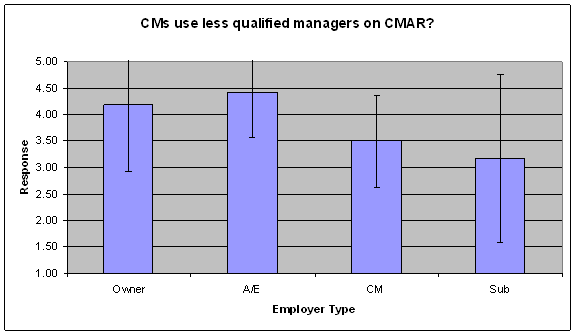
Observation
The average of all employers was 3.79, indicating strong disagreement. That is, the respondents did not feel that CMs were using less qualified people on CMR work. While all employer groups disagreed, there was a significant difference between some groups, A/E and owners disagreed 4.19 and 4.41, while subs were almost neutral on the point with 3.17. There was no trend by CMAR experience.
Analysis
It is interesting that CMs did not disagree as much as owners or A/Es. If the A/E, owners, and subs were all dealing with the equivalent individuals and situations, we could conclude that subs perceive about the same level of talent from the CMs people (indeed, they probably are the same people), while the owners and A/Es might perceive more. Hence some aspect of the CM managers appear betterxxx to the A/E and owner. Of course it may mean that only on CMAR do they deal with CM managers xxxx
See second comment.
Text Comments
If it’s cost reimbursable, they can afford to give you the best that you’re willing to pay for, and which one of us really wants to be accused of only willing to pay for second rate or unexperienced personnel on a job. If the work is obtained through price competition, then we face this argument- they can’t afford to place their best staff on a project when they have to look after every penny to be selected to begin with.
In my experience, CMs who come from a GC background tend to function more like GCs than CMs. This holds true for the site superintendents. CMs with a degreed background perform more like a CM. GCs hold all of their cards close to their chest, with virtually no cost disclosure or honest project appraisals. Superintendents with GC backgrounds tend to view their role as working only for the CM. Degreed background supers tend to relate with the owner and A/E on a higher level of parity with the CM, recognizing their larger responsibility to the success of the project as a whole.
D. Since the CM site staff are generally reimbursable, do you believe they use higher priced staff or more people than they would on similar DBB work.
Score 1-5, where 1 means strongly agree and 5 means strongly disagree.
____________Score
Observation
No trend by employer, average 3.26 indicates mild disagreement. No trend by CMAR
Analysis
None
The next two questions involve activities of the owner other than inspection/QA/QC
E. A prudent owner should have a middle-management level manager on the job at least part of each day because there are important issues of coordination with other activities of the owner, scheduling and phases, inherent complexity of the project, myriad other issue with the users, there are often many coordination issues.
Score 1-5, where 1 means strongly agree and 5 means strongly disagree.
____________Score
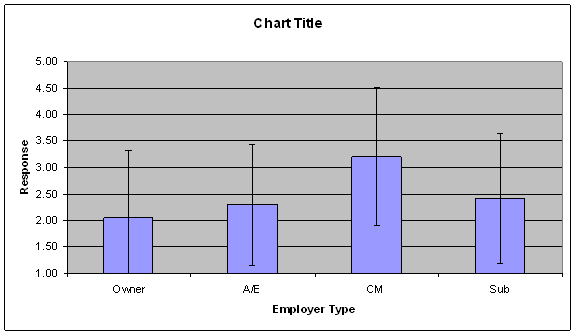
Observation
By employer, almost significant, trend that CMs at 3.2 disagreed mildly while others Owner and A/E agreed more, 2.05 and 2.29. The differences between CM and the owner, A/E and subs were significant. No trend by CMAR
Analysis
Note that CMs don’t vehemently disagree with having the owner’s rep on the site each day, they are almost neutral on the point. While ego might be threatened that the owner will kibitz or give directions to subs or find fault, the CM often needs decisions from the owner. Thus having the owner on the site might be perceived as a benefit. Hence on the average, the CMs don’t mind have the owner on the job often. The A/E and subs may feels it’s a good idea to help with decisions, but don’t feel an ego threat from the owners presence. Hence the A/Es and subs, on the average, agree more.
Text Comments
Our contracts are a fixed cost/GMP and we don’t need to be there to watch each nail be hammered in. We’re there because we are the team coach, because we represent our users, because we alone can bring the owner’s view and experience of what is important on a project and what we need as an end result. But that doesn’t require a daily presence, even during construction.
I don’t need to be there daily, but I am available daily as needed to meet the exact needs that you list and that I am the reason for in my organization.
F. “The job goes smoothest if the owner’s manager only visits the job as occasion warrants and leaves all the day-to-day jobsite oversight to the CM.”
Score 1-5, where 1 means strongly agree and 5 means strongly disagree.
____________Score
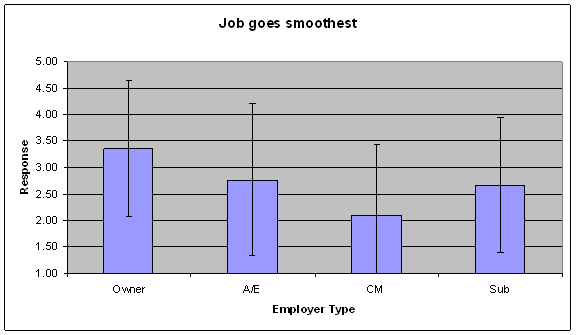
Observation
Almost significant trend, Owner 3.36 expressing mild disagreement and CMs at 2.1 expressing agreement. The differences between those two was significant. The differences between the Subs and A/E with the CM are almost significant. There was no trend by CMAR experience.
Analysis
This question might have been pejorative towards owners – implying that things are better when they don’t come around. Note though that CMs agreed more than Subs or the A/E, that is Subs and the A/E are comfortable with more owner presence. This is similar to their responses above.
Text Comments
Somewhat dependent on the scale of the project, the AE’s CA involvement, etc. It is always good to have a knowledgeable owner throughout the entire duration.
The next two questions involve the overall QA/QC, meaning the entity that hired the inspectors, reviewed the inspection reports, maintained the records, granted or refused minor exceptions.
G. On the CMR jobs you have worked, who was responsible for the overall QA/QC? Since jobs may have different organizations, average your experiences and answer by dividing 100% among the following choices
______% A/E who designed the facility
______% Owner with his own forces
______% Owner with contractors/consultant not affiliated with CM
______% CM with contractors/consultants
______% Building code authority (other than the owner)
H. In your opinion, for future jobs, how would you prefer the overall QA/QC be handled?
Again, divide 100% among the following choices
______% A/E who designed the facility
______% Owner with his own forces
______% Owner with contractors/consultant not affiliated with CM
______% CM with contractors/consultants
______% Building code authority (other than the owner)
Observation
Note, the data is difficult to interpret. I expected more uniformity in inspection responsibility – instead there was wide variation. To start with, let’s look at the combined data.
Overall
Inspection by |
Current |
Preferred |
A/E |
30 |
32 |
Owner |
10 |
9 |
Owner through a consultant |
15 |
14 |
CM |
35 |
33 |
Building Official |
9 |
12 |
There was not much difference between current practice and what was preferred.
When looking at the employer groups, let me define a difference of over 3% between current and preferred as “interesting” and more than 5% as “significant. On that basis, the Owners and A/E did not have interesting or significant preference changes, but CMs and Subs did:
Average CM |
|
Current |
Preferred |
Delta |
A/E |
14 |
22 |
-8 |
Owner |
7 |
10 |
-3 |
Owner through a consultant |
20 |
14 |
7 |
CM |
53 |
48 |
5 |
Building Official |
6 |
7 |
-1 |
Which would indicate that the CM would like to transfer some inspection responsibilities to the A/E.
Average Sub |
Average Sub |
|
Current |
Preferred |
Delta |
A/E |
25.5 |
20 |
5.5 |
Owner |
8.5 |
6 |
3 |
Owner through a consultant |
17 |
14 |
3 |
CM |
22 |
24.5 |
-2.5 |
Building Official |
27.5 |
35.5 |
-8 |
While the Subs would prefer more inspection by the building official and less by the A/E.
How each employer view the current inspection responsibilities |
|
Owner |
A/E |
CM |
Subs |
A/E |
32 |
46 |
14 |
25.5 |
Owner |
21 |
7 |
7 |
8.5 |
Owner through a consultant |
17 |
9 |
20 |
17 |
CM |
29 |
34 |
53 |
22 |
Building Official |
2 |
5 |
6 |
27.5 |
The owners see the CM and A/E as doing about the same amount of inspection, while the A/Es see themselves as doing almost half the inspection, while the CMs only see the A/E as doing 14% of the inspeciton. The subs see the building official as doing over 27% of the inspection, while the other employers see the BO as doing very little inspection. The owner see 38% of the inspection done with his own forces or with a consultant reporting to the owner, while the other employers see 17%, 27%, and 25.5%.
Subs seemed to prefer more inspection by the building official 8% and less by all the other modes. [perhaps they are more accustomed to building officials] Of the 6 subs who mentioned the BO, 5 wanted more inspection and one less. Note that for some university projects, it is likely that the owner is also the building official.
How each CMAR Experience viewed the current inspection responsibilities |
|
New |
Two -Five |
Five – Ten |
More than Ten |
A/E |
23 |
17 |
37 |
47 |
Owner |
10 |
14 |
8 |
8 |
Owner through a consultant |
19 |
21 |
10 |
8 |
CM |
43 |
40 |
37 |
24 |
Building Official |
5 |
10 |
9 |
13 |
It is interesting that, generally, as CMAR experience increased, the perception of the current portion of inspection borne by the A/E increased, and that of the CM decreased.
Based on CMAR , new seemed to want owner and CMs to do less, the others more, 2-5 years wanted CM to do less and owner and building official to do more, 5-10 not significant, over 10 wanted the A/E to do less
Analysis
There was a tremendous variation in the individual responses. For example, if we just consider the response of owners to the question what percentage of inspection the owners do on the average project, the responses were:30, 9, 5, 100, 0, 5, 0, 30, 0, 33 and one did not answer. It may be that inspection duties are quite varied, that they are changing, or just that it was a question with a somewhat involved response and it came toward the end of the survey. I caution against making any determination based on this question. In general, since there were no instances of gross changes in preferences, I would believe that, in general, assignment of inspection responsibilities in CMAR is not a big problem.
Text Comments
In general QC is improved on CMAR projects since you have selected on quals. You mentioned owner’s roles, it is CRITICAL that the owner have a strong, knowledgeable presence. The A/E loses some of the traditional power found in DBB projects and by default, the Owner has to assume the leadership role in resolving conflicts.
I’m not sure this question was written quite right. It is somewhat confusing
All of the above have the responsibility of QA/QC including the GC and Subcontractor. It should be more of a team effort and be done as the project progresses not at the end. As far as the owners despicability it depends on how sophisticated and how involved they are as to how his portion is accomplished.
I. If the costs of a design error were taken from the contractor’s contingency under the GMP, it could cost the CM if they were receiving a percentage of cost savings and/or it will reduce the CM’s contingency that might be needed for other risks.
Which do you think is fair?
___ Take it out of the owner’s contingency, since the error is not the CM’s.
___ Take it out of the contractor’s contingency, since the CM reviewed the design and is in the best position to control the cost increase.
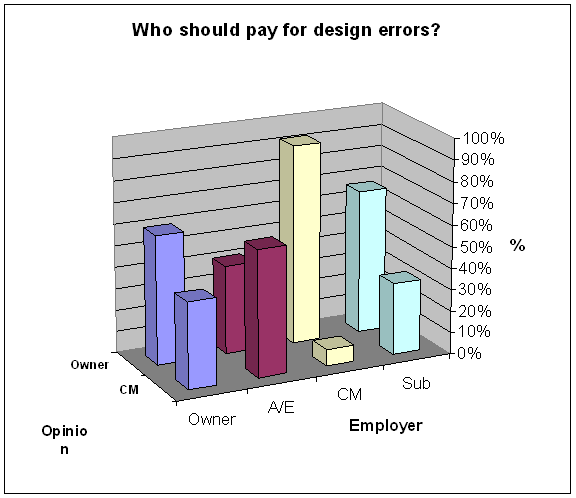
Observation
Here the result was surprising. A full 60% of the owners felt that they should be pay and only 40% felt the CM should pay. The A/Es, was reversed, 60 saying that the CM should pay. The CM is not surprising, almost all felt the owner should pay, but 33% of the subs felt the CM should pay. No trend based on CMAR experience.
Analysis
Note the owner and the A/E reversed. That is not unexpected. There is always a chance that the owner will ask the A/E to pay for a change order necessitated by a design error. By ascribing to the CM some responsibility for reviewing the design, the A/E may feel their liability is reduced. This is likely to be true for a patent error, but would be a stretch for an error that would require calculations to discover.
Text Comments
Really tough, loaded question. While it’s “my money” that the contractor has in his contingency, he’s jealously guarding its use to assure that he doesn’t run over budget. You always can increase the contingency ahead of time with the agreement to use it to cover owner change orders. Sometimes, as you get closer to the end of the job and the contingency is in really good shape since the contractor over estimated it to begin with, we all agree to allow some of it to be used for A/E change orders since I would be getting it back shortly anyway.
J. In general, do you feel the CM will “eat” minor cost increases due to design, or third party coordination issues that total less than 1% of cost and may decrease the CM’s contingency slightly, in order to, improve his chances of future work with the owner or recommendations to other owners?
Score 1-5, where 1 means strongly agree and 5 means strongly disagree.
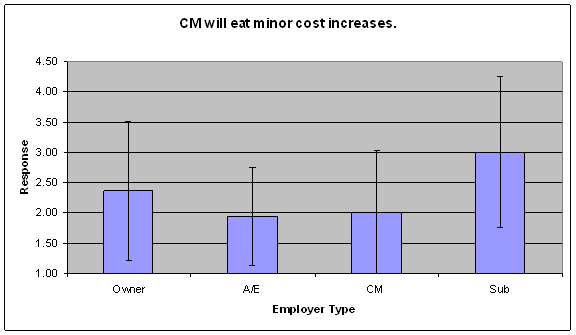
Observation
The CMs, the party that presumably knows the answer, agreed with the statement. The Owners agreed, but not as much, the A/Es agreed slightly more. The Subs were neutral, note the wide standard variance for the Subs.
Analysis
The Owner, CM, and A/E all believe that the CM will accept minor cost in order to be cooperative. The Subs agree with less with this. This may be due to the nature of the typical CMAR contract for the CMs, who are really not loosing money, but rather loosing part of their contingency. Unless they have a contract that specifies sharing of the unspent money, the CM does not pocket any of the contingency when the job is done. On the other hand, most subs have a fixed price contract and any extra expenses they do not get reimbursed for comes out of their pocket. Presumably the Subs understand the CMs fee arrangement. Another possibility is that the Subs interpreted the 1% hit by the CMs as being a cost that the CM could try to pass along to the subs. See next.
Fee reduction not likely, particularly in the current overheated market. More likely, he’s willing to work hard, cooperate, be seen as a team player, maybe not bend over backwards but at least lean backwards, to help out during a job. I’ve been told and believe that architects worry first about aesthetics then profit; for contractors, it’s the reverse. Generally, you’re negotiating the fee well in advance of the project completing- it should be before it even starts!- so why would a contractor reduce his fee, when he has nearly all of the performance that you’ll gauge him on yet to go?
They’re pretty much unwilling now- “gauge me on what I do, not what you pay me”
It will be seen how the minor costs are dealt with. In general change orders are pain, people will eat minor costs. If the contractor gets paid for every change than what is the point of GMP pricing. It would really be Guaranteed Minimum Price. That is not the concept. The contractor needs to take some risk and participate in the design because the have already got the job long in advance by qualifications instead of hard dollar.
Depends upon the circumstances and where in the project he is. He’s not “eating it”- he’s pounding it back to a subcontractor or taking it from his allowance (“my money”). It will never get as far as impacting the fee unless there’s been a serious mishandling of the project on the part of the contractor. GMP = guaranteed maximum profit.
K. In general, do you feel the subs will “eat” minor cost increases due to design errors, that total less than 1% of their contracts, which decrease their fee slightly in order to improve there chances of future work with the owner or CM?
Score 1-5, where 1 means strongly agree and 5 means strongly disagree.
____________Score
Observation
No correlation based on employer. Average of 2.85 would indicate neutral, note the wide SD. Subs had a 3.0 neutral, but the SD was 1.6. No trend for CMAR experience.
Analysis
The 3.0 or neutral response of subs would indicate neutral, neither agreeing nor disagreement with the statement. The wide SD, however, indicates they had strong opinions, but they were mixed. Here are the individual responses.
Individual Responses of Subs |
Score |
Number of Responses |
1 (Strong Agreement) |
3 |
2 |
2 |
3 |
2 |
4 |
2 |
5 (Strong Disagreement) |
3 |
Clearly, some subs felt they would eat a minor cost increase and some were sure they would not.
Text Comments
The subs are even one step farther away from the owner and future selection on merit or cost. More often, the general contractor “shoves” it downhill to the subcontractor. Most will concede a small amount of change, either vs. a small contingency that they have to protect themselves, or as a favor to the general contractor, who the sub wants more future work from. Since most sub work is done on a competitive bid basis, they still see CMAR as hard bid and are unwilling to absorb a lot of any additional cost. Margins and profits are much higher now in our local market, so there may be a bit more accommodation occurring now than it will in a tighter economy.
L. One advantage of CMR to public owners is the ability to fast track construction phases or procure long lead equipment under an existing (the CMR) contract.
Do you believe that owners in CMR utilize that ability sufficiently?
Score 1-5, where 1 means strongly agree and 5 means strongly disagree.
____________Score
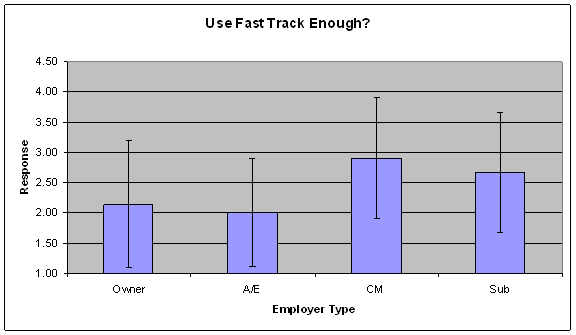
Observation
There were significant differences in the responses of owners and A/E who agreed that sufficient use of fast track is made on CMAR, while CM agreed less. There was no trend with CMAR experience.
Analysis
Since the Owner generally must approve fast tracking a particular item, they would believe that all the fast tracking they approved was a good idea and all the fast tracking they did not approve was not a good idea. In many cases fast tracking would be less competitive than regular sequencing. Hence, they would tend to believe that “sufficient” use was made of fast tracking. CMs on the other hand, would like to fast track whatever possible and practical, but might have their requests for fast tracking disapproved by the owner, hence they have less believe in fast tracking is used sufficiently. Or at least, feel this way more often than owners. One would expect Subs, who would often originate the fast tracking request, to believe similar to CMs. The reason why A/Es agree as owners is not clear.
M. Regarding the percentage of work self-performed by the CM, i.e., not subcontracted, do you believe, in general, self-performance by the CMR should be discouraged, other than minor site cleanup and safety.
Score 1-5, where 1 means strongly agree and 5 means strongly disagree.
____________Score
Observation
The average score was 3.44, indicating disagreement. CMs disagreed more than subs, 3.7 to 3.33, but that difference was not significant. There was no trend based on CMAR experience.
Analysis
The responses of the subs, who would be in a position to loose work if the CM self-performed their specialty, is not much different than that of the CMs, whose fee might increase if they self-performed. Of course it may be that the subs who responded to the survey did not feel it was likely that CM would perform their specialty, so it did not matter to them. Also, the owners, many of who like to bid the subs to demonstrate to the funding bodies that they are competing the work, did not agree either. It appears that that all the parties feel that self-performance should not be discouraged, or at least that the current level of self-performance is alright.
Text Comments
We probably don’t do it as much as we could and it’s one of the best tools in answer to soaring inflation rates. It’s probably one of the top advantages with CMAR and where owners need fast deadlines, it’s the right answer and right reason for CMAR.
It’s really not that material to us, other than it makes assuring that the contractor is providing competitive pricing much more difficult. I’d say that nearly all general contractors continue to be brokers, doing very little to none of the work themselves. Most just don’t want to carry the risk and overhead, and most can always find a subcontractor able or willing to do the work for less money. Some contractors keep a series of smaller crews and trades on when they do a lot of TI type work because they can keep them busy on smaller projects and keep a certain group of their repeat owners happy with prompt, capable small work. A very few keep some large, key trades in house, like concrete, because on large projects, those trades (ability, price, availability) are key to successful schedules. Last, some specialty general contractors keep a wide variety of trades in house because they keep doing the same type of limited scope work and would rather control the trades, take a bit of risk of higher overhead but not be paying someone else’s profit constantly- I see this in some contractors who do things like water treatment, paving, etc. Mostly, we don’t see a “choice” on whether the contractor has in-house crews or not, and it’s rarely material to us if they do or not.
General Construction Phase Text Comments
CM should be required to bid against the others for any of the work they wish to self perform. Having a CM self perform is often a benefit to the overall schedule and project management. Lots of focus on “design errors” in this section. Everyone makes mistakes, including design teams. However, in a good CM relationship, there are fewer accusations of design error because everyone is fully aware of the intentions, the schedule, etc. From the design side, because there are additional eyes on the process all along, there are fewer opportunities to inadvertently leave out information. From the CM point of view, he has an opportunity at numerous points in the process to evaluate the packages and ask questions, filling in any blanks or confusing information. The CM is expected, because a GMP is prepared prior to completion of the documents, to be carrying some contingency to fill in the “blank spaces” in the design and then they remain participants in the process of completing the design and documents. More is known throughout the process so there are simply fewer reasons to look for financial help to cover the unknowns. The Owner will be sufficiently involved to truly understand the implications of late changes and shortened schedules throughout the process. And the Owner will need to carry a reasonable contingency, which will vary depending on how early the GMP is set.
General Comments
[Our state] has been ahead of the curve for public CMAR vertical construction. It has been difficult for A/E’s since there is a loss of “control” on the project. I believe it has increased costs, but has reduced the claim rate after project close-out. In the end, the good GC’s are still good, and the bad GC’s are starting to wake up.
Why isn't the A/E held liable for a portion of the risk of design errors? PLUS With close to 30 years in the subcontractor market, both in the field and management, it is my opinion that the CM projects with the highest degree of success for both the owner and contractors all have one thing in common. The owner's representative has to have the power to exercise his decisions. When the owner appoints a rep he needs to report to the owner's president or CEO. This enables him to make a decision without the fear of losing his job or getting mired in the muck of interoffice politics. This lack of indecision from the very top is what creates the very first step of efficiency and in the end will bring a project in under budget and ahead of schedule. Every job with a owner's "team" has been extremely cumbersome.
I believe CMR is a better delivery system. It helps if the Architect can be a part of the selection committee in selecting the CMR. This would help to achieve a good “match”. The CMR needs to do a better job of conceptual cost estimating. This is the No. 1 problem at the moment. The CMR needs to pay the subs during pre-construction. It is difficult to get a sub interested if he’s not getting paid. He’s already busy doing “paid” work. I fear the subs aren’t giving our job the attention is deserves.
Self-performing concrete and some other subs is fine, especially with the allocations of concrete recently.
Question M. is totally dependant on the project and the CMR’s capabilities – no generalization can be made. L. often times there is not a venue to contract for those long lead items early enough because the CMR portion doesn’t convert to construction early enough.
I have had 2 different experiences with CMAR; one positive and one negative. I based my answers on the positive experience only.
































